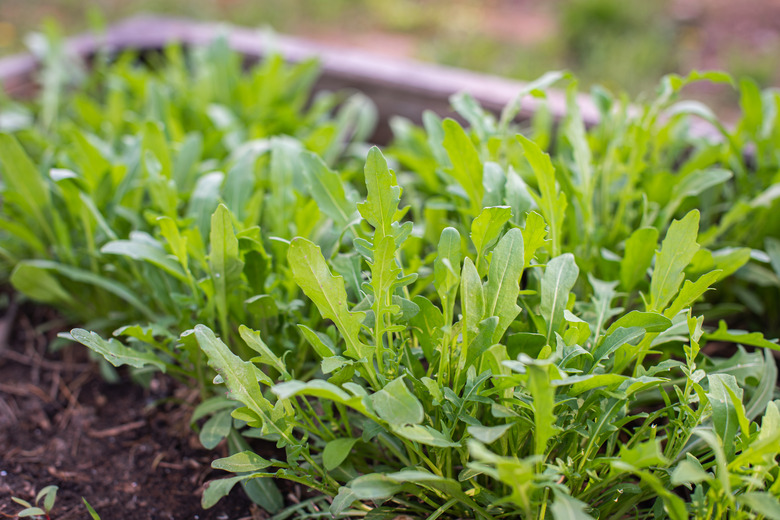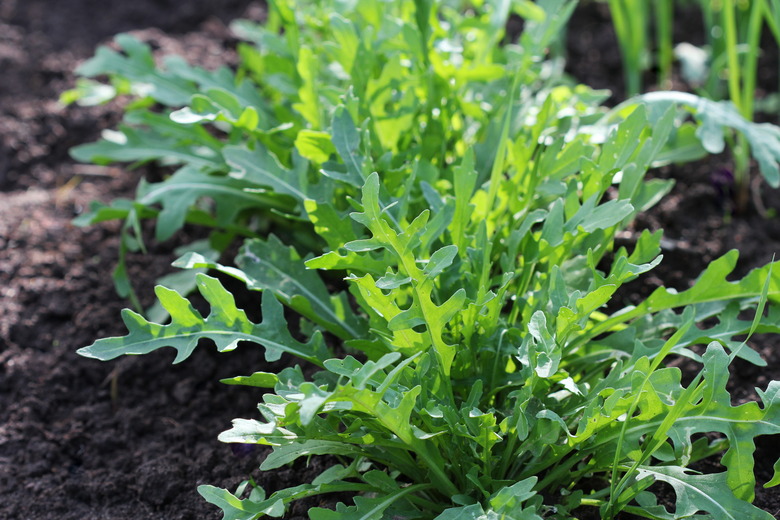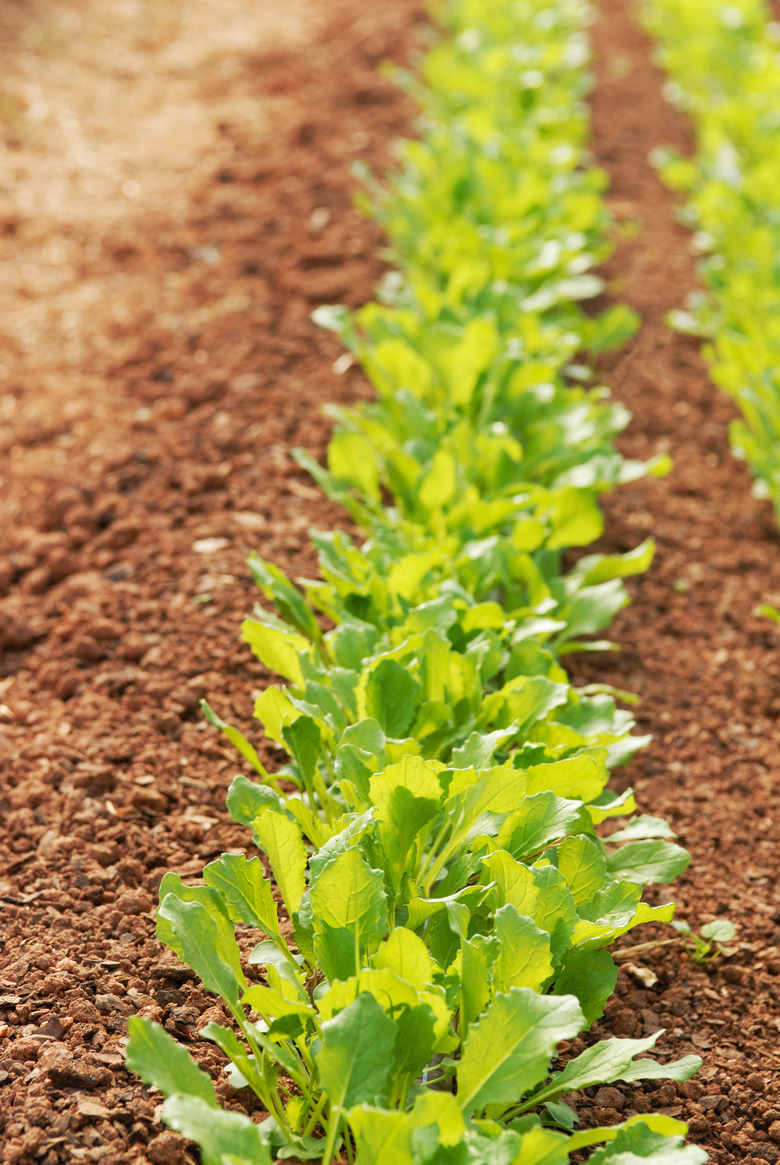How To Grow Arugula
Arugula (Eruca vesicaria) is a cool-weather annual that grows well when planted in spring or fall. Perhaps most common for its role inside a package of mixed spring salad greens, its leaves are tastiest when young and harvested before the plant goes to flower. Arugula is relatively easy to grow, even in limited space situations for which container gardening is the best option. Since it grows quickly, arugula can be planted throughout the growing season for a steady supply of tasty salad greens.
Best Uses for Arugula
Arugula, also known as rocket, is most often used as a salad green, imparting a slightly peppery flavor to the dish. This leafy green that's a relative of mustard is also tasty in soups, shredded up as a pizza topping or used on a sandwich in place of lettuce. It even works well in a lasagna in place of spinach, in orzo dishes with tomatoes or even as an ingredient in a pesto for a pasta dish.
This green is a healthy addition to meals, as it's high in nutrients and fiber. Arugula contains calcium, iron, potassium and magnesium as well as vitamins A, B, C and K. Certain compounds within arugula may help battle inflammation or even some forms of cancer.
Although the plant flowers, arugula isn't generally used for ornamental purposes in the garden. Its white flowers are edible, so they come in handy to add a decorative touch atop a salad or on the dinner plate alongside a special meal.
How to Grow Arugula
- Common Name: Arugula
- Botanical Name: Eruca vesicaria
- When to Plant: Spring or fall in cool weather
- USDA Zones: Grown as an annual in zones 2-11
- Sun Exposure: Full sun, partial shade
- Soil Type: Moist, nutrient-rich soil
- When it's in Trouble: Brown spots on leaves, yellowing leaves
- When it's Thriving: Produces healthy green leaves
Starting Arugula From Seed
Sow arugula seeds 1/4 inch deep directly in the garden after watering the soil until it's moist. Although arugula grows in just about any soil, it does best in a nutrient-rich soil, such as garden soil mixed with compost. Sow seeds several inches from one another. If planting rows, space the rows about 10 inches apart from one another. Arugula also does well in raised beds or in containers provided the container is at least 6 inches deep and wide.
Keep the soil moist until the seeds germinate, which should be in several days or less than a week. Once the plants grow, they can be thinned to about 6 inches apart to ensure sufficient air circulation that's vital to healthy plant growth. Sow seeds every few weeks throughout the spring and early summer so you'll have plenty of young leaves to harvest throughout the season. If you continue sowing through hot-weather months, use a row cover to keep the plants a little cooler or just stop for a while and resume sowing in early September once the weather cools.
If you prefer to start the seeds indoors in spring, use compostable starter pots and a quality potting mix, such as an organic mix made for vegetables. Start your seeds four to eight weeks before the last frost in your area so the young seedlings will be ready to transplant in four to six weeks. Compostable pots can be gently torn along the bottom and side so the seedling can be transplanted pot and all into the garden once it's ready.
Although typically grown from seed, arugula seedlings are sometimes available at garden centers. Plant seedlings you've started or purchased on fertile soil in the garden, in raised beds or even in containers. As with the seeds, arugula seedlings prefer a nutrient-rich soil, so mixing in a little compost is a good way to provide nourishment.
Carefully plant the seedlings deep enough to cover the exposed roots, packing the soil around the stem so the plant stays up well on its own. The hole depth should be approximately as deep as the starter pot housing the seedling. Keep the soil moist, especially the first week or so as the arugula recovers from transplanting and gets used to its new home.
In What Zone Does Arugula Grow Best?
There is no singular zone that's best for arugula, but it does better in cool growing conditions than in sweltering heat. It's ideal for cool and moderate USDA plant hardiness zone, such as 2 through 7. If you live in a relatively hot region that generally doesn't dip below freezing, such as zones 10 or 11, adjust the planting season so the arugula experiences as much cool weather as possible. Feel free to plant in October through December to harvest arugula through the winter and early spring.
If left to grow as the weather heats up in spring, the plant may go to flower, resulting in leaves that are less palatable. To boost your arugula supply, sow seeds every couple of weeks as soon as cool weather arrives in autumn for a continual supply of greens. Shade cloth may help the plant fare a little better in Southern summer heat, but flavorwise, it's better to grow arugula only during cooler seasons.
When Should You Plant Arugula?
Since arugula prefers cool growing conditions, it's best not to plant it during the hottest days of summer, as the flavor of the leaves gets a bit too strong, and the plant goes to flower quicker. Arugula handles a little frost well, so it's OK to plant it even before the final frost early in the year. Sow it directly into the ground one or two weeks before the last expected frost of the season but not much earlier than that, or it may be too cold for the seeds to germinate.
If planting in late summer or in early autumn for fall harvesting, plant it a couple months ahead of the first expected frost so it has ample time to grow. Even if the frost comes early, you'll still have the chance to harvest some young leaves; once established, an arugula plant is able to tolerate a little frost. Arugula that is planted toward the end of summer once the hottest weather passes may even produce better than spring plantings because the plant is less likely to produce flowers as the weather gets progressively cooler. This means more opportunities for leaf growth, which means more young leaves to harvest.
Soil, Sunlight and Water Recommendations for Arugula
Although arugula isn't incredibly picky, it prefers a moist, well-drained soil with a pH between 6 and 8. Compost mixed into the soil before planting nourishes the arugula while also helping the soil retain moisture. Arugula does well in full sun in cooler weather; light shade is ideal in areas prone to hot weather.
A little mulch atop the soil helps suppress weeds while allowing the soil to retain more moisture. Keep the soil moist but not soaking wet, especially when the plant is young and establishing itself. If the top inch or so of the soil feels dry, it's time to water.
How to Harvest Arugula
Arugula is best harvested when its leaves are young and tender, which happens in as little as six weeks after germination. Look for leaves that are at least a couple inches long and a healthy green color. Young arugula leaves have the best flavor; some feel the plant becomes too peppery as its leaves age or after the plant bolts and goes to flower. Break off the young leaves from the outer areas of the plant so the main arugula stalk isn't harmed; this promotes more growth.
As the hot days of summer settle in, the plant may go to flower. Either leave the plant intact to harvest the flowers for salads or cut it back nearly to the ground, which may encourage new growth. Leaving some of your arugula plants to go to flower and to seed may allow the plant to reseed itself, resulting in more arugula for later in the season.
Common Pests and Other Problems for Arugula
Although arugula is fairly resistant to pests, flea beetles and aphids are common causes for concern. Flea beetles, which are only 1/16 inch long, are sometimes hard to spot thanks to their small size and their ability to leap like a flea. Various species may be found around arugula and other garden plants, and these pests don't all look the same. They may be tan, a shiny black or several mottled colors. In many cases, it's easier to spot the damage than the insects themselves.
Flea beetle larvae feed on plant roots, while adult beetles eat holes in arugula leaves. While the holes in the leaves aren't a major cause for concern, the beetles may spread plant diseases between crops. Young arugula is especially susceptible to flea beetle damage, as older plants are better able to withstand the pests. Look for numerous holes that cause arugula leaves to have a lacy appearance. Sticky traps may catch some flea beetles.
Aphids are also tiny and are often found on the underside of plant leaves or sucking sap from the plant stems. A few aphids may cause only a little damage to plant leaves or stems, but in mass quantities, these pests are a major problem to quite a few garden plants. If you find aphids on arugula or other nearby plants, dislodge them by spraying them with a gentle stream of water from your garden hose or sprayer.
Common Diseases for Arugula
Bacterial leaf spot and downy mildew are common issues for arugula. Bacterial leaf spot or bacterial mildew causes brown spots on arugula leaves, and it may cause entire leaves to yellow. In some cases, this is caused by too much water hitting the leaves when watering the plants. Water the ground rather than the plants' leaves to help prevent the issue. If entire plants are affected, it's best to remove them from the ground, as this bacteria-based problem may spread.
Downy mildew is another problem arugula faces when its leaves are exposed to excessive moisture. This also shows up as brown or yellow patches atop the leaves, yet in this case, there's also a white mildewy matter on the underside of the leaves. This problem sometimes spreads by spores in the air, exacerbated by poor air circulation between plants. Remove affected plants from the ground and discard them. Thinning plants and watering the soil rather than the plant leaves helps prevent this issue.
References
- North Carolina State University: Eruca vesicaria
- Missouri Botanical Garden: Eruca versicaria subsp. sativa
- Monticello Shop: Arugula Seeds (Eruca vesicaria sativa)
- Gardener's Supply Company: How to Grow Arugula
- Bonnie Plants: Growing Arugula
- Penn State University Plant Village: Arugula
- University of Florida IFAS Extension: 12 Easy to Grow Vegetables for South Florida (Zone 10) Gardens
- The Old Farmer's Almanac: Flea Beetles
- Ortho: Aphids
- WebMD: Arugula


